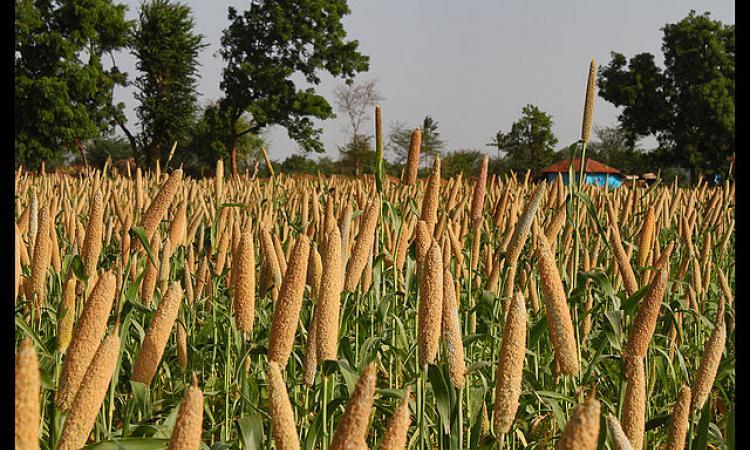
Ending poverty and hunger
There has been a considerable shift at the policy level in India from the focus on enhancing food production - to promoting farmers’ welfare and nutritional security, in recent years informs this paper titled 'Pattern of crop diversification and its implications on undernutrition in India' published in Current Science.
This is because agriculture in India is in a crisis due to human induced anthropogenic changes such as land diversion, degradation and fragmentation of agricultural landholdings along with climate change. This has highlighted the need for finding alternatives to make farming a viable and profitable option, especially for small and marginal farmers.
Ending poverty and hunger has been one of the important priorities globally. The Sustainable Development Goal ( SDG2) focuses on a global commitment to tackle undernutrition and hunger and acknowledges the need to promote sustainable agriculture for achieving food security and improved nutrition.
Undernutrition among children and adult populations in India continues to be high and crop diversification has been identified as one of the important steps that can be undertaken to deal with malnutrition in the country.
What is crop diversification?
Crop diversification refers to a shift from the regional dominance of one crop to the regional production of several crops. It can greatly help to reduce the vulnerability of small farmers towards climate change.
According to ICAR, “Crop diversification involves addition of new crops or cropping systems to agricultural production taking into account the different returns from value-added crops with complementary marketing opportunities. Crop diversification and inclusion of the new varieties can be one of the important technologies in increasing the farmers’ income to a certain extent, if not double. The aim of crop diversification is to increase crop portfolio so that farmers are not dependent on a single crop to generate their income” (Source: Indian Farming 68 (01) : pp 32. January 2018)
In India, diversification varies by regions and lower crop diversification is more common among poor and smallholder farmers. Diversification among food crops has been found to be extremely important from a nutritional point of view to increase food security and reduce undernutrition among populations.
However, studies that show the connection between crop diversification and nutritional status in India are limited. This paper discusses the findings of a study that used district-level data to assess the relationship between diversification in food crops and nutritional status in India.
The study
The study covered 21 major Indian states that included Andhra Pradesh, Assam, Bihar, Chhattisgarh, Gujarat, Haryana, Himachal Pradesh, Karnataka, Kerala, Jammu and Kashmir, Jharkhand, Madhya Pradesh, Maharashtra, Odisha, Punjab, Rajasthan, Tamil Nadu, Telangana, Uttarakhand, Uttar Pradesh and West Bengal, which contribute more than 90 percent of gross cropped area to the agricultural sector in India.
The diversification and nutrition indices were estimated for 549 districts across these states. The crops included for the aanalysis included cereals and millets, pulses, fruits and vegetables, sugar, spices and condiments, and oilseeds.
Extent of crop diversification in Indian states
District-wise diversification indices were estimated for the states considering the area under food crops. The study found that:
- The districts with low to medium degree of food crop diversification included the northern states of Punjab, Haryana, Jammu and Kashmir, Uttar Pradesh and Uttarakhand, ;the eastern states of Bihar and Odisha and central states of Chhattisgarh and Jharkhand.
- The southern states of Karnataka, Tamil Nadu, Kerala and the central state of Madhya Pradesh showed very high diversification index and rice, maize, pulses, oilseeds, and fruits and vegetables were the major crops cultivated in this region.
- The extent of diversification was low especially in Punjab and Haryana, as more than 90 percent of the area in these states was under wheat and rice. This was also found to lead to degradation of natural resources. About 80 percent of the gross cultivated area in Odisha and Bihar was under cereals and millets, indicating low level of diversification in the region.
Nutritional status by states
- The states of Jharkhand, Bihar, Gujarat, Madhya Pradesh, Odisha, Maharashtra, West Bengal, Uttar Pradesh, Chhattisgarh and Rajasthan were found to perform very low in terms of nutritional index. Jharkhand, Bihar and Madhya Pradesh were the worst affected.
- Assam, Andhra Pradesh, Haryana, Karnataka and Telangana were medium performing states while Kerala, Punjab, Jammu and Kashmir, Uttrakhand, Himachal Pradesh and Tamil Nadu were found to perform very high in terms of nutritional outcomes.
- Districts of Punjab, and Jammu and Kashmir showed low food crop diversification, but improved nutritional status. This was perhaps because of the higher income status of these states.
The study found a strong negative relationship between food crop diversification and undernutrition status of the districts. Thus, higher degree of diversification within food crops was linked to the reduced probability of undernutrition.
The findings of the study have important policy implications for bridging regional disparities in nutritional outcomes in India and focus on the need to:
- Promote diversification among food crops to improve the nutritional outcomes of districts showing under performance.
- Focus on crop neutral policies regarding price support, access to inputs and other infrastructure, value-chains and market linkages favoring diversified food systems.
- Address lacunae associated with resource-use efficiency, sustainability, market logistics, regional demand–supply gap and the income demands of farmers, argues the paper.
The paper can be accessed here